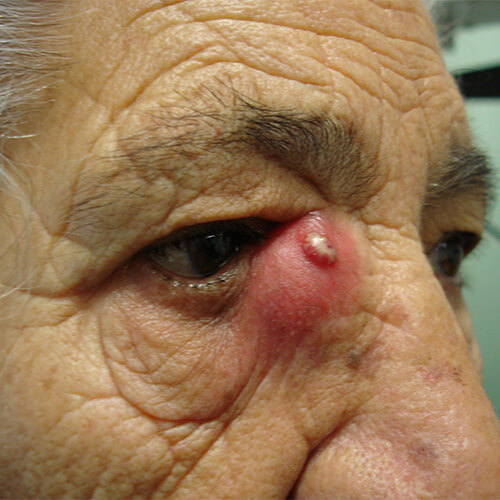
-
What is dacryocystitis
Dacryocystitis is inflammation/infection of the lacrimal sac via which the tears drain from the eye into the nasal cavity. which typically occurs secondarily to obstruction within the nasolacrimal duct and the resultant backup and stagnation of tears within the lacrimal sac.
Dacryocystitis is inflammation/infection of the lacrimal sac via which the tears drain from the eye into the nasal cavity. which typically occurs secondarily to obstruction within the nasolacrimal duct and the resultant backup and stagnation of tears within the lacrimal sac.

-
How does dacryocystitis occur
Dacryocystitis typically occurs secondary to obstruction of the nasolacrimal duct. Obstruction of the nasolacrimal duct leads to stagnation of tears in a pathologically closed lacrimal drainage system, with the stagnated tears providing a favorable environment for infectious organisms.
The lacrimal sac will then become inflamed leading to the characteristic erythema and edema at the inferomedial portion of the orbit.
-
Etiology of dacryocystitis
The etiology of dacryocystitis can be divided into acute, chronic, acquired and congenital causes.
Acute dacryocystitis is typically infectious in origin. Chronic dacryocystitis is due to chronic obstruction of the nasolacrimal system.
Acquired causes of dacryocystitis include trauma such as nasoethmoid fractures, surgeries such an endoscopic or endonasal sinus procedures, neoplasms, and certain medications such as timolol, pilocarpine, idoxuridine, and trifluridine.
Congenital forms of dacryocystitis are typically due to obstruction of the valve of Hasner, located in the distal portion of the nasolacrimal duct.
-
Symptoms of dacryocystitis
Presentation differs for acute and chronic dacryocystitis.
In acute dacryocystitis, the symptoms may occur over several hours to several days and is characterized by a sudden onset of pain, erythema and edema of the medial canthus and the area overlying the lacrimal sac at the inferomedial portion of the orbit. The redness commonly extends to involve the bridge of the nose. Very often, purulent material can be expressed from the puncta, and tearing may be present.
In cases of chronic dacryocystitis, excessive tearing is the most common symptom. Increased tearing may lead to the production of a tear film and mattering. Changes in visual acuity may also be present due to tear film production.

-
Diagnosis of dacryocystitis
The diagnosis of dacryocystitis is generally made clinically based off of the patient’s history and physical exam.
-
Management of dacryocystitis
In general, dacryocystitis is a surgical disease. Surgical success rates in the treatment of dacryocystitis are approximately 95%.
Acute cases are best treated surgically after the infection has subsided with adequate antibiotic therapy. For uncomplicated cases, oral antibiotics with gram positive coverage should be given. Complicated cases require intravenous antibiotics.
Chronic dacryocystitis almost always dictates surgery for correction of symptomatology.
In cases of congenital dacryocystitis, treatment begins conservatively with massage (parents are taught how to perform the massage at home), and antibiotics are prescribed for the treatment of acute flares. 90% of cases resolve by one year with conservative measures.
The patients who fail conservative treatment often undergo lacrimal probing, which is successful in 70% of cases. In still unsuccessful, surgical interventions are needed.
Eyelid, Lacrimal & Orbital Diseases
Learn more about the disease you are interested in

